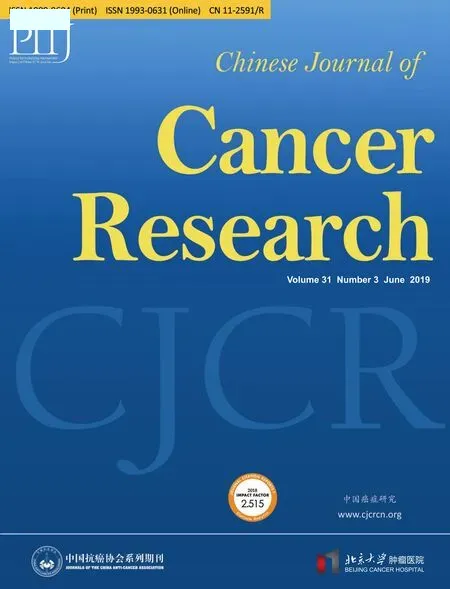Management guidelines for esophageal carcinoma 2018: Chinese standards in clinical practice
2019-02-17YuanFengNanWu
Yuan Feng, Nan Wu
Key Laboratory of Carcinogenesis and Translational Research (Ministry of Education/Beijing), Department of Thoracic Surgery II, Peking University Cancer Hospital & Institute, Beijing 100142, China
Esophageal carcinoma is now the sixth most common cause of cancer-related deaths worldwide. China, unfortunately,locates in the highest-risk area (often referred to as the“esophageal cancer belt”) spanning from northern Iran through the Central Asian republics and into northern China. The high prevalence areas spread from south to north in China. In the highest prevalence areas, the crude incidence of esophageal cancer can even reach more than 100/100,000, nearly 7 times that of the whole country.More than 210,000 patients die from esophageal cancer in China every year, accounting for half of the esophageal cancer-related death worldwide. It is currently one of the most threatening cancers for Chinese people.
The esophageal cancer in China is different from that in Western Europe and North America. The majority of the histological subtype of esophageal cancer in China is squamous cell carcinoma, accounting for more than 90% of the cases. Besides alcohol abuse and smoking, the major risk factors for Chinese people also include intaking of foods with nitrosamine or contaminated with mold/fungi(especially for patients with low socioeconomic status).Although National Comprehensive Cancer Network(NCCN) guidelines on esophageal cancer has been increasingly accepted by thoracic surgeons in China, simply copying the practice in Europe and North America may not the best choice for the treatment of esophageal cancer in China. Under this condition, the Chinese Society of Esophageal Cancer, Chinese Anti-Cancer Association organized experienced experts nationwide to publish the first edition of Chinese Guidelines for Diagnosis and Treatment of Esophageal Carcinoma, which is different from the NCCN guidelines, in April 2011. The guidelines described the consensus, controversies and suggestions on diagnosis and treatment of esophageal carcinoma,demonstrating the clinical experience and outcomes of researches on esophageal cancer in China. It effectively guided the practice in China during the past years.
However, the past 7 years witnessed the rapid development of technologies on diagnosis and treatment of esophageal cancer, especially the development of endoscopic mucosal resection (EMR), endoscopic submucosal dissection (ESD) and other minimal invasive methods. Thus, last year, the Chinese guidelines for diagnosis and treatment of esophageal carcinoma (2018 edition) was released by the National Health Commission of the People’s Republic of China (1).
Besides keeping all the merits of the former edition, the new guidelines admits and absorbs the new advances of conceptions and technologies on care of patients with esophageal cancer, further confirms the role of endoscopic and minimal invasive technologies on the screening,detection and treatment of early esophageal cancers. In order to secure the standard procedure of EMR, ESD,surgical pictures and detailed descriptions were utilized to illustrate these technologies, which are rare in guidelines of other countries or regions.
In addition, the new edition of guidelines introduces the Chinese standard of thoracic lymph nodes grouping for esophageal carcinoma, which firstly released in 2017. By referring to the American Joint Committee on Cancer/Union for International Cancer Control (AJCC/UICC)and Japan Esophageal Society (JES) systems and constructing on basis of the current condition of Chinese patients and clinical practice, the Chinese standard of lymph nodes grouping system matches the characteristics of Chinese patients (e.g. more carbon deposition and calcification). The groups of the lymph nodes can be easily recognized and dissected by surgeons, and the order of the groups is designed for convenient lymph nodes dissection and surgery quality assessment.
The 2018 edition of the guidelines also rules the protocol of pathological access, tissue selection, analysis and report in details. It helps minimize the heterogenicity of pathological access and analysis nationwide and may eventually contribute to the counseling of higher-level cancer centers or hospitals on the specimen obtained in local hospitals.
However, the course of esophageal cancer is extremely complex. Although much efforts and progresses have been made by the involved surgeons, oncologists and pathologists, more researches and evidence are still needed to improve the new edition of the Chinese guidelines of diagnosis and treatment of esophageal carcinoma 2018. We sincerely hope the controversies and uncertain conclusions revealed by the guidelines could guide the future design of high-quality, prospective, randomized clinical trials, and the results of these trials may help improve the guidelines in turn. The construction of such a virtuous circle will promote the researches of diagnosis and treatment of esophageal cancer, and eventually benefit the patients with this threatening disease.
Acknowledgements
None.
Footnote
Conflicts of Interest: The authors have no conflicts of interest to declare.
杂志排行
Chinese Journal of Cancer Research的其它文章
- Mutant p53 increases exosome-mediated transfer of miR-21-3p and miR-769-3p to promote pulmonary metastasis
- Hexokinase II promotes the Warburg effect by phosphorylating alpha subunit of pyruvate dehydrogenase
- Adjuvant hormone therapy after radical prostatectomy in highrisk localized and locally advanced prostate cancer: First multicenter, observational study in China
- Cancer IgG, a potential prognostic marker, promotes colorectal cancer progression
- Burden of colorectal cancer in China, 1990-2017: Findings from the Global Burden of Disease Study 2017
- Impact of crizotinib on long-term survival of ALK-positive advanced non-small-cell lung cancer: A Chinese multicenter cohort study
